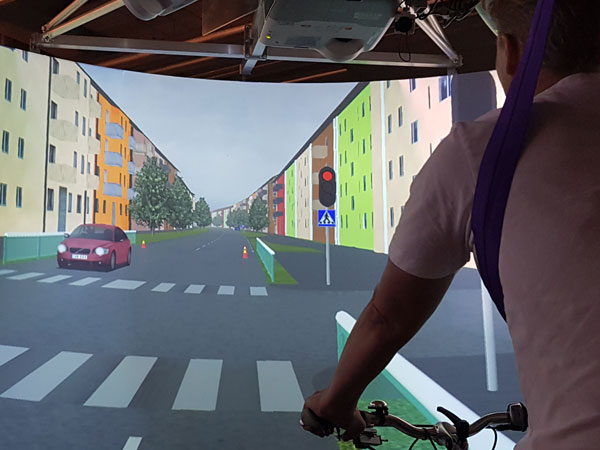A project is currently underway in which VTI’s recently developed bicycle simulator is being used to study the interaction between cyclists, and drivers. The aim is to investigate how different infrastructure designs and types of vehicles influence cyclist behaviour at intersections.
The project is led by Ramboll with VTI and Lund University as participating partners. The project consists of several parts: literature studies, observations, field and simulator studies, surveys and risk analysis. VTI’s main contribution consists of a survey for cyclists, where Katja Kircher and Jonas Ihlström have carried out much of the work, as well as a study in the newly developed bicycle simulator, which is now being used for the first time. The study was planned by Birgitta Thorslund and Anders Lindström.
“As this was the first study in the bicycle simulator, we didn’t want to make it too complicated. We therefore came up with a design to look at the cyclist’s placement at intersections,” says Birgitta, who heads VTI’s part of the project.

Jesper Sandin, VTI, test driving VTI’s new bicycle simulator. Photo: Birgitta Thorslund/VTI.
The bicycle simulator was developed by VTI as part of a now completed project funded by Vinnova. The simulator uses the platform Sim IV in Gothenburg, which makes it a unique facility.
“The VTI bicycle simulator is an exciting tool for studying cyclists and their interaction with other road users in a repeatable and controlled manner. But since it is a new facility, we need to learn how to best put it to use,” says Fredrik Bruzelius, who does research on vehicle dynamics. He developed the simulator together with Bruno Augusto and Andreas Käck.
Simulator tests
The simulator tests within the study have just been completed and a total of 33 individuals participated. The test subjects were between 30 and 50 years of age, with an equal distribution of men and women, all between 170–180 cm tall. Before the real simulator tests began, a pilot test was carried out with the project reference group, who all got to try out the simulator.
“It was then suggested that we recruit test subjects of the same height to ensure that they all had the same visual impression of the scenario”, says Birgitta Thorslund.
Each test subject was asked to cycle eight times through an intersection with traffic signals, featuring a different design for each passage. The cyclist had to share the road with a passenger car or lorry that had stopped at a red light in the intersection at the start of each scenario. The design of the intersection changed each time, either by leaving a broad or narrow space between the vehicle and the edge of the road, i.e. the space available to the cyclist, or by providing a specially indicated lane for cyclists.
The test subjects had to answer a number of questions both before and after cycling. These questions were intended to find out how the test subjects normally behave in traffic and why they chose to do what they did during the actual simulation.
“After the test, we asked questions about the experience of cycling in the simulator and how their behaviour was affected by the design of the intersection and the presence of the motor vehicle,” says Birgitta Thorslund. The aim is to learn more about how cyclist behaviour is influenced by different infrastructures and other vehicle types.
About the project
This project is funded by Vinnova’s programme Strategic Vehicle Research and Innovation (FFI) and will continue throughout 2019. It will be completed at the start of 2020, when the results are published.
 Contact:
Contact:
Birgitta Thorslund
birgitta.thorslund@vti.se
VTI, Sweden






Follow us: